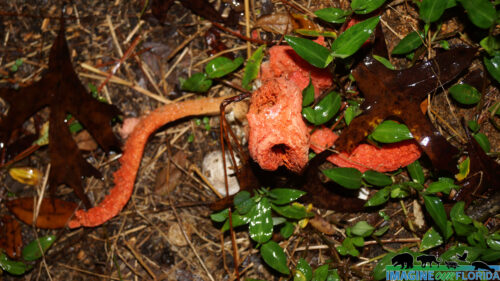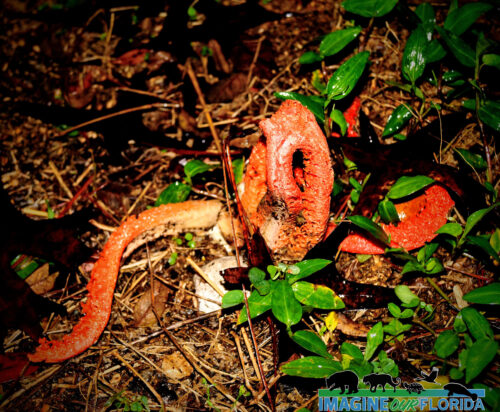The Stinkhorn, a fungus commonly found in Florida backyards and wooded areas where there is decomposing matter, is an unusual specimen, to say the least. This mushroom, which is in the same family as puffballs, is a non-poisonous, stinky fruiting body that is reported to smell like carrion and sewage. Typically, the stinkhorn is seen in its fruiting body stage, developing an elongated shape (consider the stinkhorn’s genus, Phallus.) and colors a shade of green and bright red. There are several types of stinkhorn found in Florida, but the photos below are of the Columned Stinkhorn.
Despite the stinkhorn’s grotesque appearance and stench, the fungus plays an incredibly important role in Florida ecosystems. Just as bees use flowers for nectar and spread pollen, the stinkhorn uses flies and other insects to spread its spores. The stinkhorn develops a section upon the top of the fruiting body in which it contains its stinky mass of spores. The offensive stench attracts all sorts of insects which in turn come to feast on the gleba (the spore mass). Unknowingly, the insects now carry the spores within them, which they then spread to different areas via their excrement. A fascinating example of symbiosis in our very own backyards.
Though the stinkhorn may smell disgusting, the fungi are instrumental in the function of a healthy ecosystem and should be left alone to live out its short life cycle. Moreover, even if one wishes to remove a fungus from their yard, the mycelium
below the fruiting body is extensive and highly resilient to fungicides, making their complete eradication impossible. Best to leave the little stinkhorn to its important work as a decomposer.


